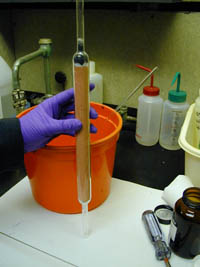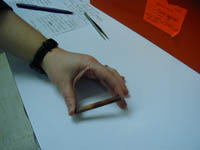
 |
|
|
|
Add a final piece of quartz wool (1/4 inch) over the Copper Oxide layer and compact it with the glass rod to secure it in the tube.
|
 |
|
Insert the copper diffusion plug into the tube so it rests on the quartz wool above the Copper Oxide layer. Insert the Silver Gauze into the outlet of the tube below the Copper Plus layer. |
 |
|
Materials Required:
|
|
Condition the Chemicals: Before filling the Combustion Tube, you must first condition the chemicals by heating them in a muffle furnace to remove traces of moisture and carbon.
Fill the crucibles with the 3 chemicals and place them in a muffle furnace set at 900°C for 30 minutes. *Make sure to place the crucibles in the furnace while it is cold and then let everything come up to temperature at once.
|
|
Once the time has lapsed, remove the crucibles using tongs and heat resistant gloves and place them on the ceramic plate in the desiccator to cool.
Leave the lid off the desiccator until crucibles have cooled substantially. Place lid on desiccator until you are ready to make the new tube. |
|
Use a paper funnel and pour in approximately 2 inches of the conditioned EA- 1000.
Tap the glass with the handle of the screwdriver to settle the reagent and add more reagent to equal the final 2 inch thickness. Insert another piece of quartz wool to form a divider over the layer of EA-1000 . |
|
Add 1 inch of Silver Vanadate, tap lightly, add more as needed (to equal the 1 inch thickness), and insert a layer of quartz wool into the narrow portion of the tube securely so the chemicals will not not pass through the tube.
Insert some quartz wool into the base of the Vial Receptacle and place it into the tube through the large end so it rests just above the indentation in the tube. Insert the Silver Gauze into the narrow outlet of the tube below the Silver Vanadate layer. |
| |
 Return
to Index
Return
to Index |